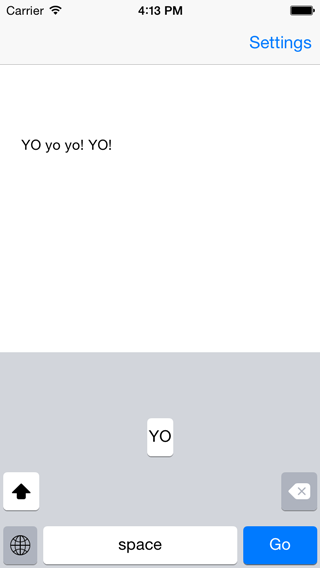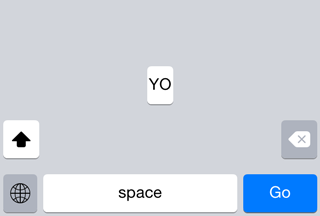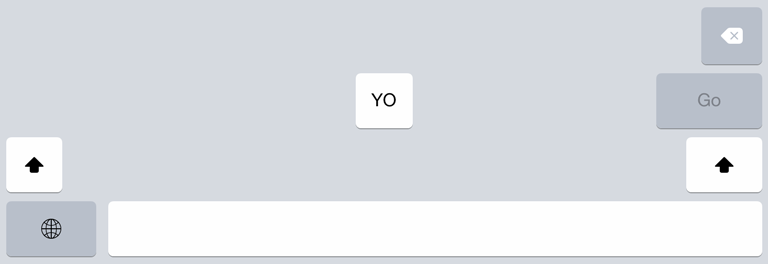ACKeyboard
ACKeyboard is a keyboard extension for iOS that mimics the system keyboard, except it has only one 'letter' key: "yo".
Description
The project contains two targets:
- the keyboard extension
- an application to test the keyboard with different settings
The keyboard has the following features:
- iPhone and iPad layout
- portrait and landscape support
- light and dark appearances
- capitalization
- repeat delete
- end of line punctuation
- auto-enable return key
The keys have the following features:
- drawn with core graphics
- light, dark, blue (for enter key) styles
- regular and lock (shift) keys
- different per-device color sets
See my post about ACKeyboard for more details.
Screenshots
iPhone portrait:
iPhone landscape:
iPad portrait:
Demo
Run the demo application in the iOS simulator to try it out.
To enable the keyboard, open the Settings app and go to:
General > Keyboard > Keyboards > Add New Keyboard... > ACKeyboard
Extending and making your own keyboard
Keys
To make a key with a title:
ACKey *key = [ACKey keyWithStyle:ACKeyStyleLight
appearance:ACKeyAppearanceLight
title:@"A"];
or to make a key with a picture:
ACKey *key = [ACKey keyWithStyle:ACKeyStyleLight
appearance:ACKeyAppearanceLight
image:[UIImage imageNamed:@"global_portrait"]];
being a UIControl subclass, a target-action can be associated to the key for an event:
[key addTarget:self
action:@selector(keyTapped:)
forControlEvents:UIControlEventTouchUpInside];
and the key can be added as a subview:
key.frame = phoneKeyboardMetrics.frame;
[self.view addSubview:key];
The ACLockKey is a special key that can be locked, like the "shift" key. An image for the lock state can be specified:
lockKey.lockImage = [[UIImage imageNamed:@"shift_lock_portrait"] imageWithRenderingMode:UIImageRenderingModeAlwaysTemplate];
and it can be locked with, for instance a double tap:
...
[lockKey addTarget:self action:@selector(shiftButtonTapped:)
forControlEvents:UIControlEventTouchDown];
[lockKey addTarget:self action:@selector(shiftButtonDoubleTapped:)
forControlEvents:UIControlEventTouchDownRepeat];
...
- (void)shiftButtonDoubleTapped:(ACLockKey*)lockKey {
lockKey.locked = ! lockKey.isLocked;
}
Metrics
iPhone and iPad keys layout are defined in PhoneKeyboardMetrics.h and PadKeyboardMetrics.h. All the calculation is done manually, without autolayout, to prevent some occasional jerkiness.
The dimensions are calculated by doing linear interpolation:
CGFloat letterKeyWidth = LINEAR_EQ(keyboardWidth,
kPhoneKeyboardPortraitWidth, 26.0,
kPhoneKeyboardLandscapeWidth, 52.0);
where, here, 26.0 and 52.0 are measured key width for portrait and landscape.
Appearance
The keyboard implements a light and dark appearance (ACLightAppearance and ACDarkAppearance).
The color sets can vary with the device type. The device can be checked with the UIDevice+Hardware category:
if ([[[UIDevice currentDevice] machine] hasPrefix:@"iPhone4,1"]) {
blueKeyColor = [UIColor colorWithRed:9/255.0
green:126/255.0
blue:254/255.0
alpha:1.0];
}
Documentation
If you have appledoc installed, you can generate the documentation by running the corresponding target.




